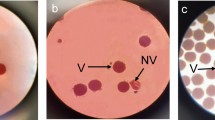Abstract
To develop an efficient screening method for detection of the transgene in Chinese cabbage (Brassica rapa spp. pekinensis) utilizing Basta spray, optimal conditions for Basta application were examined in this study. Two transgenic Chinese cabbage lines were obtained through Agrobacterium-mediated transformation and used as transgenic positive controls in the Basta screening experiment. Differential concentrations of glufosinate-ammonium were sprayed into three different growth stages of 12 commercial Chinese cabbage cultivars. The results showed that no plants could survive higher than 0.05% glufosinate-ammonium, and plants at the 2–3 leaf stage were most vulnerable to glufosinate-ammonium. On the other hand, no damage was observed in the transgenic control plants. Reliability of the Basta spray method was proven by showing perfect co-segregation of the tolerance to glufosinate-ammonium and the presence of the bar gene in T1 segregating populations of the transgenic lines, as revealed by both PCR and Southern blot analyses. Using the developed Basta screening method, we tried to investigate the transgene flow through pollen dispersal, but failed to detect any transgene-containing non-transgenic Chinese cabbages whose parents had been planted adjacent to transgenic Chinese cabbages in field conditions. However, the transgene was successfully detected using Basta spray from the non-transgenic plants bearing the transgene introduced by hand-pollination. Since the Basta spray method developed in this study is easy to apply and economical, it will be a valuable tool for understanding the mechanism of gene flow through pollen transfer and for establishing a biosafety test protocol for genetically modified (GM) Chinese cabbage cultivars.



Similar content being viewed by others
References
Arias DM, Rieseberg LH (1994) Gene flow between cultivated and wild sunflowers. Theor Appl Genet 89:655–660
Arriola PE, Ellstrand NC (1996) Crop-to-weed gene flow in the genus Sorghum (Poaceae): spontaneous interspecific hybridization between johnsongrass, Sorghum halepense, and crop sorghum, S. bicolor. Am J Bot 89:1153–1160
Cho HS, Cao J, Ren JP, Earle ED (2001) Control of Lepidopteran insect pests in transgenic Chinese cabbage (Brassica campestris ssp. Pekinensis) transformed with a synthetic Bacillus thuringiensis cry1C gene. Plant Cell Rep 20:1–7
Dale PJ (1999) Public concerns over transgenic crops. Genome Res 9:1159–1162
Dale PJ, Clarke B, Fontes EMG (2002) Potential for the environmental impact of transgenic crops. Nat Biotechnol 20:567–574
Daniell H (2002) Molecular strategies for gene containment in transgenic crops. Nat Biotechnol 20:581–586
Hammond SM, Caudy AA, Hannon GJ (2001) Post-transcriptional gene silencing by double-stranded RNA. Nat Rev Genet 2:110–119
James C (2004) Global status of commercialized transgenic crops. ISAAA (The International Service for the Acquisition of Agri-biotech Applications), Ithaca
Jun S, Kwon S, Pack K, Paek K (1995) Agrobacterium-mediated transformation and regeneration of fertile transgenic plants of Chinese cabbage (Brassica campestris ssp. pekinensis cv. Spring Flavor). Plant Cell Rep 14:620–625
Mascia PN, Flavell RB (2004) Safe and acceptable strategies for producing foreign molecules in plants. Curr Opin Plant Biol 7:189–195
Matzke AJM, Matzke MA (1998) Position effects and epigenetic silencing of plant transgenes. Curr Opin Plant Biol 1:142–148
Metz PLJ, Stiekema WJ, Nap J (1998) A transgene-centered approach to the biosafety of transgenic phosphinothricin-tolerant plants. Mol Breed 4:335–341
Pfeilstetter E, Matzk A, Feldmann SD, Schiemann J (2000) Rapid and efficient screening of phosphinothrichin tolerant oilseed rape (Brassica napus) with a novel germination test. Euphytica 113:119–124
Quist D, Chapela IH (2001) Transgenic DNA introgressed into traditional maize landraces in Oaxaca, Mexico. Nature 414:541–543
Rieger MA, Lamond M, Preston C, Powles SB, Roush RT (2002) Pollen-mediated movement of herbicide resistance between commercial canola fields. Science 296:2386–2388
Robertson WR, Clark K, Young JC, Sussman MR (2004) An Arabidopsis thaliana plasma membrane proton pump is essential for pollen development. Genetics 168:1677–1687
Schilter B, Constable A (2002) Regulatory control of genetically modified (GM) foods: likely developments. Tox Lett 127:341–349
Vaucheret H, Beclin C, Fagard M (2001) Post-transcriptional gene silencing in plants. J Cell Sci 114:3083–3091
Yang Z, Jin H, Plaha P, Woong B, Jiang G, Woo J, Yun H, Lim Y, Lee H (2004) An improved plant regeneration protocol using cotyledonary explants from inbred lines of Chinese cabbage (Brassica campestris ssp. Pekinensis). J Plant Biotech 6:235–239
Zhang FL, Takahata Y, Xu JB (1998) Medium and genotype factors influencing shoot regeneration from cotyledonary explants of Chinese cabbage (Brassica campestris ssp. Pekinensis). Plant Cell Rep 17:780–786
Zhang FL, Takahata Y, Watanabe M, Xu JB (2000) Agrobacterium-mediated transformation of cotyledonary explants of Chinese cabbage (Brassica campestris L. ssp. pekinensis). Plant Cell Rep 19:569–575
Acknowledgment
This work was partially supported by a grant (Code# 20050401034779) from the BioGreen21 Program, Rural Development Administration, and the Ministry of Science and Technology of the Republic of Korea.
Author information
Authors and Affiliations
Corresponding author
Rights and permissions
About this article
Cite this article
Lim, C., Kim, S., Choi, Y. et al. Utilization of the bar gene to develop an efficient method for detection of the pollen-mediated gene flow in Chinese cabbage (Brassica rapa spp. pekinensis). Plant Biotechnol Rep 1, 19–25 (2007). https://doi.org/10.1007/s11816-006-0002-3
Received:
Accepted:
Published:
Issue Date:
DOI: https://doi.org/10.1007/s11816-006-0002-3




